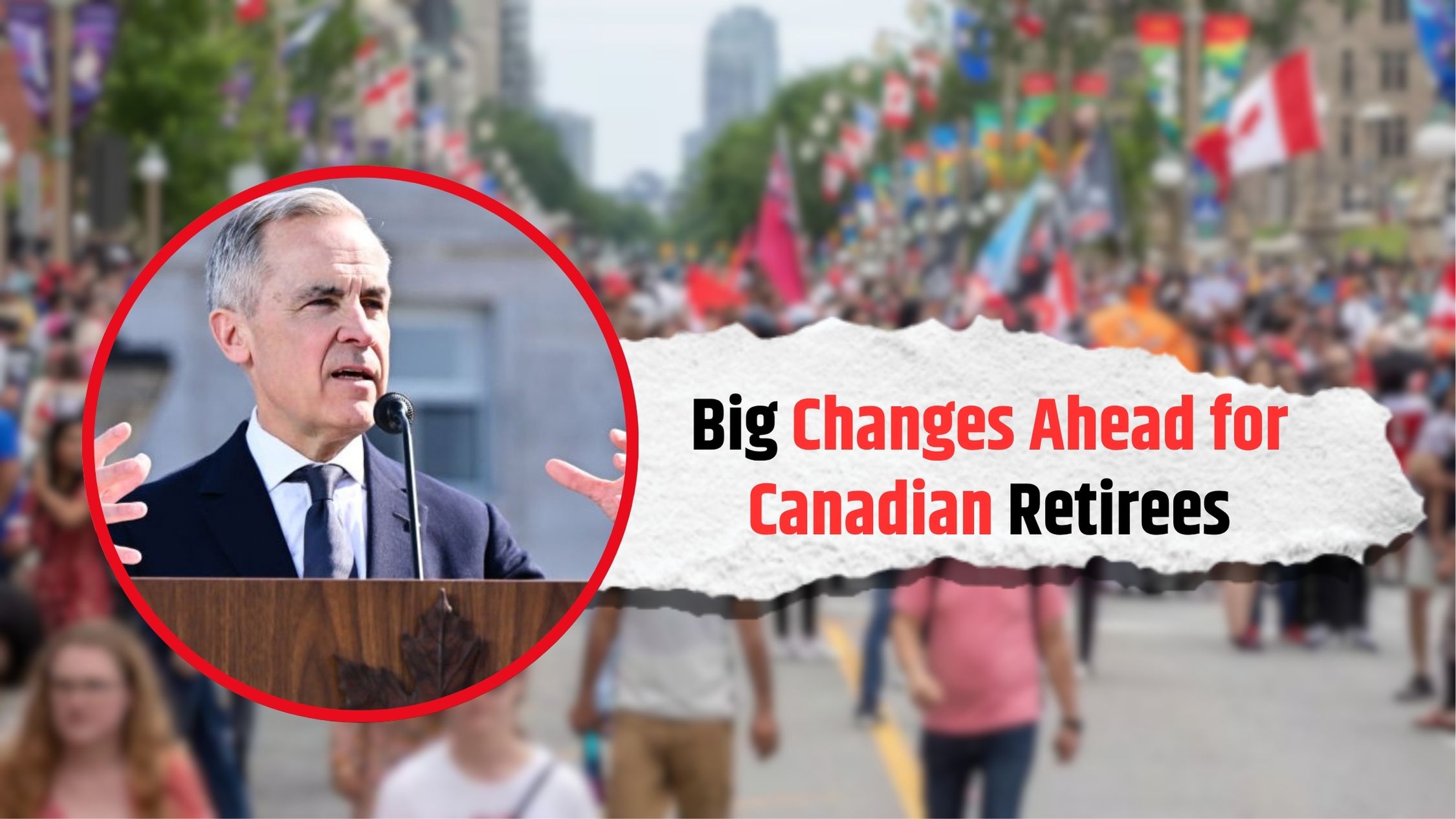As Canada moves into the second half of 2025, the retirement age debate is once again dominating headlines. With economic uncertainty, rising living costs, and a rapidly aging population, federal and provincial governments are under increasing pressure to revise the country’s pension framework—especially the age at which Canadians can begin receiving full benefits.
Behind these discussions are a series of policy proposals focused on the Canada Pension Plan (CPP) and Old Age Security (OAS). Some would gradually increase the retirement age to 67, while others look to give seniors more flexible withdrawal and tax options. These changes are not yet final but could significantly alter the retirement landscape in the years ahead.
Key Drivers Behind the Push to Raise Retirement Age
(Aging population and rising costs put stress on pension programs)
Several long-term trends are driving the push to raise Canada’s retirement age:
- An aging population: By 2030, over 20% of Canadians will be aged 65 or older.
- Longer life expectancy: Canadians are living longer, often drawing pensions for 20+ years.
- Higher cost of living: Inflation continues to push up prices for housing, healthcare, and food, which hits seniors hardest.
- Strain on CPP and OAS: With more people retiring and fewer workers paying into the system, there’s growing concern about the long-term sustainability of these programs.
Together, these factors are prompting policymakers to look for ways to protect the future of pensions—even if it means making difficult adjustments.
What’s Being Proposed in 2025?
(Overview of retirement age and pension system reform ideas)
Multiple retirement-related proposals are currently being reviewed at various levels of government. While no single plan is confirmed yet, the following policy suggestions are gaining traction:
| Proposal | Current Rule | Proposed Change | Affected Group |
|---|---|---|---|
| Retirement Age | 65 | Gradual rise to 67 by 2030 | All workers under age 60 |
| Partial Pension Withdrawal | From age 60 | Flexible with part-time work | Early retirees |
| CPP Contributions (High Earners) | Flat rate | Higher tier for top earners | High-income professionals |
| Pension Deferral Incentives | Optional bonus | Larger bonus for late retirees | Seniors delaying retirement |
| Tax Credits for Working Seniors | Limited | Broadened access | Workers aged 65+ |
These changes aim to balance economic sustainability with fairness. While encouraging longer careers, the proposals also offer new options for phased retirement, potentially benefiting those who want to ease out of full-time work.
How Will This Impact Different Age Groups?
(Personal retirement planning could shift under new rules)
The impact of the proposed changes will differ based on your age and career status:
- If you’re 60–64: You may need to wait longer for full pension access, unless flexible partial withdrawal rules apply.
- If you’re already retired: Your current CPP or OAS payments are safe, though future cost-of-living adjustments or incentive bonuses may change.
- If you’re under 50: Expect to face a higher retirement age (likely 67), along with higher CPP contributions, particularly if you’re a high-income earner.
Critics warn that these changes could hit blue-collar workers and rural Canadians hardest, especially those in physically demanding jobs. Advocates say flexibility in withdrawals and added credits could offset those effects.
Public Reaction Remains Divided
(Citizens and advocacy groups clash over fairness and feasibility)
In 2025, public sentiment on retirement reform is deeply divided:
- Urban professionals: Many support the gradual increase, citing longer lifespans and better health as reasons to work longer.
- Rural and low-income workers: These groups argue a blanket age increase is unfair, particularly for those in trades, agriculture, or physical labor.
- CARP (Canadian Association of Retired Persons): This leading advocacy group has spoken out against raising the age, arguing it would penalize seniors who can’t afford to delay retirement.
- Political parties: The issue has created clear lines—some parties back reform for financial sustainability, while others defend early-access rights for seniors.
Any policy update is likely to include a mix of changes—increasing retirement age gradually while introducing supportive measures for vulnerable workers.
Key Concerns from Senior Advocacy Groups
(Why retirement age hikes raise equity questions)
Groups like CARP and regional senior coalitions have raised the following concerns:
- Not all jobs can be performed into your late 60s
- Lower-income seniors may have shorter life expectancy
- Delayed pensions could increase senior poverty
- Pushing back retirement may reduce job openings for younger Canadians
Advocates stress that policy must be flexible and inclusive, especially for people with limited employment choices or health conditions.
Your Next Steps: How to Prepare for Retirement Policy Changes
(Planning early can ease the transition)
Even though nothing is confirmed, Canadians should start adapting their retirement plans to account for possible policy shifts. Here’s what you can do:
- Check your CPP and OAS projections using the My Service Canada Account
- Increase savings in RRSPs or TFSAs to reduce dependence on public pensions
- Explore phased retirement or part-time work options
- Stay informed about legislative updates in your province
- Speak with a financial advisor if you’re nearing retirement
The more prepared you are now, the easier it will be to adapt if new laws take effect by 2030.
How Flexible Retirement Could Work in the Future
(Encouraging part-time work and phased exits from the workforce)
A growing trend in 2025 is flexible retirement—an idea gaining favor among policymakers and economists. Rather than setting a hard retirement age, these proposals aim to:
- Let seniors draw partial CPP or OAS while working part-time
- Increase deferral bonuses for those who delay retirement beyond age 65
- Provide tax credits to seniors who remain employed
- Allow job-sharing or lighter workloads for older employees
This approach could benefit both the economy and individuals by reducing financial stress and allowing smoother transitions out of the workforce.
Balancing Pension Reform with Fairness
(Preserving retirement security without leaving anyone behind)
As Canada looks to modernize its retirement system, striking a balance between sustainability and fairness will be key. Pension systems must remain solvent—but not at the expense of equity or dignity.
Experts recommend a combination of:
- Gradual retirement age increases
- Expanded flexibility for partial retirement
- Extra support for those in high-risk or physically demanding jobs
- Clear communication and support tools to help Canadians understand their rights and options
These strategies can help ensure that Canada’s retirement policies are ready for the future—without abandoning the needs of today’s seniors.
FAQs on Canada Retirement Age Changes 2025
1. Is Canada’s retirement age officially increasing in 2025?
Not yet. Proposals are being reviewed to gradually increase the retirement age to 67 by 2030, but no final law has been passed as of now.
2. Will current retirees be affected by these changes?
No. If you’re already receiving CPP or OAS benefits, your payments are not at risk under the current proposals.
3. What happens if I work past age 65?
You may qualify for additional tax credits and larger CPP deferral bonuses if you delay retirement and continue working.
4. How can I prepare for a potential increase in retirement age?
Start by reviewing your expected pension income, saving more in RRSPs or TFSAs, and considering part-time or phased retirement options.
5. Who is most impacted by these proposals?
Workers under the age of 60—especially those in physically demanding roles or with lower incomes—may be most affected by a delayed retirement age.





